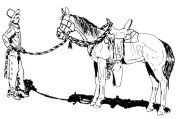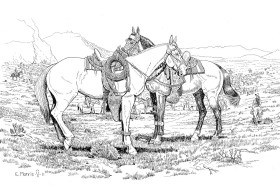Some Thoughts on the Hackamore
The following discussion is printed with permission from the author, Gwynn Turnbull-Weaver. |
By Gwynn Turnbull WeaverThere are many different ideas floating around the country about the hackamore and how it is to be used. Its very makeup seems to be a mystery to many and its function even more elusive. How such a simple concept became so complex is beyond many dyed in the wool traditionalists but, be that as it may, some information about the hackamore is outlined here. The snaffle bit came into play late in the game, in vaquero terms – showing up en mass when the British came onto the scene. Until then, the hackamore ushered most new mounts onto the payroll. It is no mystery to most that horses were started later in life in our not so distant past. Genetics, feed and the rigors of ranch life deemed it so. “Older blooded” horses were colder blooded horses – maturing later both mentally and physically. Feed, at least in many arid regions, fluctuated with the seasons and sparse times, along with long outside winters, held growth in check for many colts. It was not uncommon then for horses to grow substantially, well after their fifth or sixth year on earth. What seems to stump most folks is the reasoning behind schooling the horse with the absence of a bit. Since the use of a bit is the end result down the road and since the horse has, in most modern day cases, already accepted the snaffle bit in its mouth, why then would we “change up” in mid stream and go to the hackamore? The most basic answers can be found straight from the horse’s mouth. The ChangingOne concept that fostered and continued the advocation of the hackamore was the changing nature of a horse’s mouth; particularly during the years that the teeth doing the changing are the ones directly involved with the bit. This seemed to line up with a horse’s coming four to coming five year old years. The changing of teeth marked the time a horseman did well to keep out of Mother Nature’s way and steer clear of their horse’s potentially sore and sensitive mouth. Unfortunately, most modern-day trainers ignore the changing of a horse’s teeth. The best of horsemen are sensitive to the horse’s demeanor, ever searching for the subtle hints that indicate and instruct him on his journey. Only the keenest of horsemen, while paying attention to the messages their horse sends to them, understands that the condition of the animal’s mouth is one message he would do well to consider. The hackamore was the obvious solution; it afforded the horseman the freedom to continue using and advancing his mount through the changing of his teeth. What most horsemen never counted on, however, was the added benefits the change offered them, while working through the differences the hackamore brought to light. The MakingsHackamores come in many different sizes and diameters, as well as different materials. Natural products are a must. They are more forgiving Most traditional hackamores are made of braided rawhide. The good ones are braided around a natural core. That core might be a piece of worn out reata, twisted rawhide or perhaps an old piece of worn out horse hair mecate. They may be braided from eight to thirty-two strings with the average number of strings used hovering around twelve to sixteen. Sometimes another leather is used to make the strings and may be used in combination with the rawhide or alone. The diameter of the hackamore needs some discussion. There are basically three types of braided “hackamore” type pieces of equipment. The hackamore, as we are discussing in this article, is the piece of equipment used alone, in the earlier stages of training. It is held to the horse with a simple leather “hanger” – a simple headstall, usually made of a softer leather and tied at the near side of the horse’s head. It is used with a horse hair mecate, traditionally. The hackamore is usually 3/8″ to 7/8″ in diameter. The next level of equipment, for definition’s sake, is the small “two rein” variety, usually 1/4″ to 5/16″ in diameter, and is worn with the bridle and a small mecate. The third piece of equipment often confused with the hackamore is the even smaller “underbridle bosal” used with a shorter lead mecate for finished bridle horses. It is often delicate, usually not more than 1/4″ in diameter, fitting subtly beneath the bridle. It is a lead as well as a mark of distinction for the bridle horse. The “true” hackamore of this article is the larger of the three. The Eye of The NeedlePerhaps we may never be able to lead a camel through the eye of a needle but the vaquero has successfully ridden a horse through one, delicately threading their horses through their maneuvers. The hackamore man does not drag his horses around by the nose, but rather places the hackamore in different positions and encourages his mount to willingly maintain a body posture that supports those positions. The hackamore stage of training is perhaps the most risky stage of the game. How a cowboy manages himself and his horse during the hackamore process may critically define the horse’s future sensitivities. If misused or abused, a horse will quickly learn to “run through” the hackamore. Heavy hands and erratic cues can numb a horse quickly and destroy any respect the horse may have for the most basic cues like “stop” or maybe even “slow down.” Once a horse has been wrongly taught to ignore the cowboy’s cues in a hackamore, serious ground will be lost in regards to training that may never fully be regained. Much is at stake when the hackamore goes on and a good hand knows and honors the unique idiosyncrasies of his equipment. A Good FitThe hackamore should fit comfortably on the horse’s nose, much like a hat is fitted to a human head. Not too tight, not too loose. It should be fairly soft while still retaining a measure of firmness and shape. A hackamore that is too soft loses all its structure and balance. One that is too hard might be severe or awkward, loading large amounts of pressure in small areas. Sores and tenderness may result. Typically, pain is distracting. Horses will focus on that pain or irritation and miss the subtler cues the rider is offering him. As mentioned, the hackamore is used with a mecate to provide the correct feel and weight. The mecate, when wrapped and tied properly, helps to size the hackamore to the particular horse as well as weight it in such a way it hangs as it should and releases when it should. Though there have been gimmicks added to the hackamore and odd, more severe offshoots have been designed, the traditional hackamore, when made correctly and used as it was designed to be used, offers a comfortable fit and a balanced presentation. Horsemanship Exposed |




